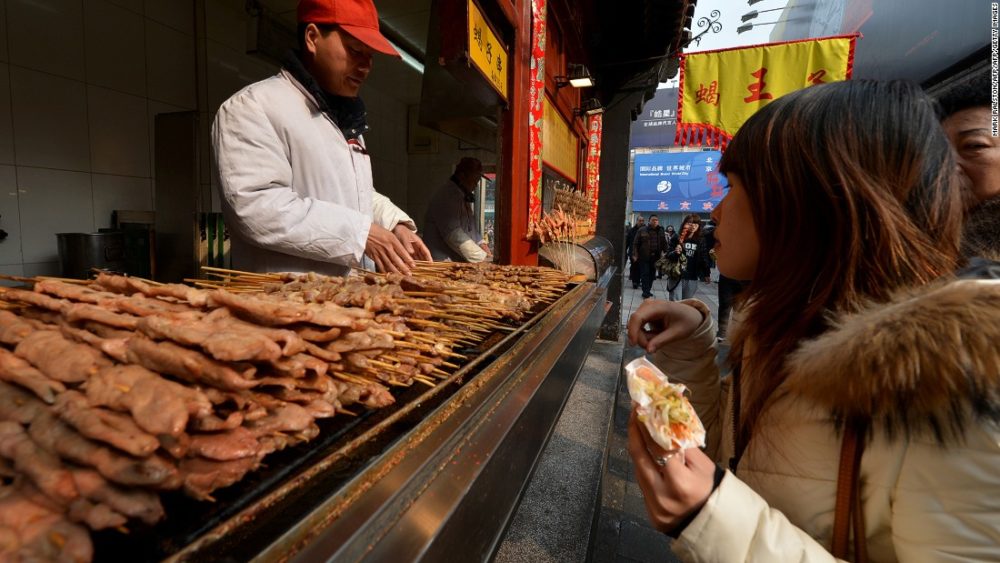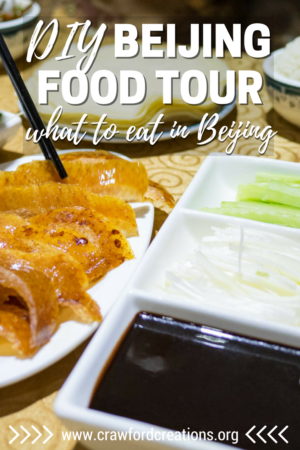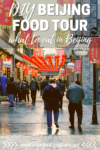DIY Beijing Food Tour: What To Eat In Beijing
***This post may contain affiliate links.***
Let’s talk about food. Some of you know how I feel about Chinese food already, but for those who don’t, I’ll summarize. It’s awesome. In fact, I truly believe that China is one of the best countries in the world to explore if you’re a foodie.
Honestly, I’m not quite sure how I feel about using the word “foodie” but I’ve come to define myself as one in the sense that I love food, and I love trying new foods and dishes from other countries and regions of the world.
If you’re a food lover like me, not only will you love China in general, but you will most definitely love Beijing. There were two things I was excited about before visiting Beijing for the first time this year, one was the Great Wall, and the other was the food.
Beijing is home to two of China’s most famous dishes, Beijing Duck (otherwise known as Peking Duck) and dumplings. I had also heard they had really good stick meats, and let’s be honest, who doesn’t love a good stick meat?
I was actually thinking of booking a food tour in Beijing for about a millisecond until a quick Google search revealed just how ridiculously expensive they are. So I quickly threw that plan out the window and made a list of all the local foods I wanted to try while I was there. In essence, I created my own do-it-yourself Beijing food tour. And seriously, who needs a guide when you can speak and read Chinese?
I know, I know, most of you reading this are not proficient in Chinese, but trust me, you don’t have to be. All of these foods will be easily identifiable based on the photos in this post, or a quick matching game of the Chinese characters if you happen to find yourself at a restaurant without pictures or English on the menu.
Related Posts
- The Foodie’s Guide To China: Must Try Chinese Foods By Region
- How To Spend A Long Weekend In Beijing: The Ultimate 3-Day Itinerary
- The Complete Guide To Hiking The Jinshanling Great Wall
What Is Beijing Food?
Beijing food is seriously some of the best in all of China, and it appeals to virtually all palates. It’s not spicy, but you can still find spicy food, it’s sweet, meaning you can actually find desserts (don’t get too excited, there’s no chocolate), and they eat more wheat-based products like bread and noodles than most other parts of China, which, us western folks tend to really enjoy, I know I do.
If you’re planning a trip to China and are wondering what to eat in Beijing, look no further. Get ready to try some awesome Beijing local food without the price tag of booking a guided Beijing food tour.
DIY Beijing Food Tour
There are lots of traditional Beijing foods out there to try, but we’ve narrowed down your choices to what we think are the 10 best Beijing foods you must try when visiting the city. You, your taste buds and your wallet are going to love this DIY Beijing food tour. Let’s dig in.
1. Beijing Roast Duck 北京烤鸭 (Beijing kaoya)

Probably China’s most famous dish, Beijing Duck is eaten as a soft taco of sorts with crispy duck skin, duck meat, cucumber, green onion, and a barbecue type sauce inside. How it works in the restaurant is that you order a whole roast duck which is then brought out to your table where they first slice off just the skin and arrange it on a plate, then they slice up the duck breast and arrange that on another plate, and then they bring out a platter of all the condiments as well as a pile of crepes. Then, in true DIY food tour style, you make your own duck wraps at the table.
Once you’ve gotten all your food for the wraps, the chef will take the duck into the back and chop up the remaining carcass and meat. The rest of the duck then gets brought back to your table for you to munch on, that is if you’re even hungry enough to eat it after gorging yourself on all the duck crepes you’ve made.
One order of Beijing Duck can generally feed a family of 4 people. Plus you can always order side dishes at the restaurant as well. We ordered one duck plus two side dishes for 3 people, mostly because we just wanted to try a bunch of different dishes, and it was entirely too much food. We would have been good with just the duck.

Where To Find The Best Roast Duck in Beijing
You can find Beijing Kaoya at any Roast Duck restaurant in Beijing, but one of the best, and cheapest places in Beijing to eat Beijing duck is at Deyuan Roast Duck Restaurant located on Dashilan Pedestrian Street.
Address
57 Dashilan West Street, Beijing
北京市西城区大栅拦西街57号
2. Dumplings 饺子 (jiao zi)

Dumplings, a ubiquitous Chinese food known, and bastardized, around the world. Beijing dumplings are unlike any dumplings you’ve ever tried. As in they really are that much better.
I literally have no idea why, but I assume it has to do with however they marinate their filling mixture. The dumplings in Beijing, like most places in China, are boiled, not fried. Now how a boiled dumpling can be so good, sauce not included, is one of Beijing’s yummy mysteries.
Beijing dumplings are filled with either pork or beef usually mixed with a vegetable such as cabbage, green onion, or mushrooms and wrapped up in a noodle dough like wrapper. The dumplings are boiled, strained, and then served plain on a plate. Condiments on the table are generally black vinegar, chili paste, and occasionally soy sauce.
Where to Find The Best Dumplings in Beijing
The best places to eat dumplings in Beijing are at little hole in the wall mom and pop dumpling restaurants. Look for a place that serves only dumplings and you’ll be in for a treat.
3. Shredded Pork In Beijing Sauce 京酱肉丝 (jingjiang rousi)

Jingjiang rousi was actually one of the first dishes I ever had in China, and it stuck in my mind for just being so different from any Chinese food I’d ever had in America, and because it was actually amazing.
Shredded pork in Beijing sauce is another one of those DIY burrito type dishes. Strips of pork are cooked in a sweet barbecue type sauce and served with sides of cucumbers, green onion, cilantro, and tofu skin wrappers.
Yes, you read correctly, tofu skin wrappers. It’s not anything like you’re thinking I promise (if you think that sounds gross that is). It’s just a super thin sheet of tofu that basically acts a tortilla, just made of tofu instead of flour.
Where To Find The Best Jingjiang Rousi in Beijing
Honestly, every jingjiang rousi dish I’ve ever had has been delicious and tasted exactly the same, so I have no specific recommendations for this one. You can order this dish at any sit-down restaurant in Beijing. It’s a classic.
4. Fried Sauce Noodles 炸酱面 (zhajiang mian)

Fried sauce noodles, kind of an unassuming name, I know. But if you’re going to try one noodle dish in Beijing, this is the classic local bowl of noodles you need to try.
Zhajiang mian is a rather unconventional Chinese noodle dish, as it’s served at room temperature, and is one of the closest dishes to a noodle salad that you can come by in China. Which seems strange to me that it’s so popular in Beijing being that it gets rather cold up there.
Anyway, here’s what you’re getting when you order fried sauce noodles. It’s hand-pulled noodles that are boiled, strained, and put in a bowl served with a soybean sauce, raw cucumber, radish, bean sprouts, and green onion on top.
This is definitely a mix before eating type of dish. The taste is kind of a savory sweet combo with a good crunch from the raw veggies. I like it as one of the foods I miss eating a lot of in China is salad of any kind as they don’t generally serve raw vegetables at restaurants here.
Where To Find The Best Zhajiang Mian In Beijing
Zhajiang mian is served all over Beijing, but in general, the best places to get it are at a little noodle shop. Any noodle restaurant in Beijing will serve up a great portion of fried sauce noodles.
5. Fried Crepe 煎饼 (jian bing)

These fried crepes, known as jianbing in Beijing, are one of the cities greatest street food inventions. Locals typically eat jianbing for breakfast, so your best chance at finding one is in the morning.
Jianbing is a made to order super thin crepe with egg, savory sauce, chili paste (if you want), chopped green onion, cilantro, and a giant crispy fried noodle inside. The whole thing is folded up and fried on the griddle. Om nom nom.
When I find jianbing where I live in Zhuhai, one serving is actually half of the giant crepe wrap, which makes an awesome snack, but in Beijing they do it up right and serve you the entire thing. It’s huge and is definitely a meal in its own right so if you’ve already eaten breakfast and you’re buying one just to try, be sure you’ve got some friends or family around to split it with.
Where To Find The Best Jianbing In Beijing
Jianbing is typically a breakfast food, but more specifically it’s a street breakfast food, so look for vendors making these fried crepes as you walk down the street in the morning.
Beijing has been cracking down on street vendors in the past year, so to find jianbing look for a stand sitting on the sidewalk or like a little mini shop along the road. The telltale sign is if they have a flat circular griddle in front of their shop.
6. Candied Hawthorn 糖葫芦 (tang hulu)

Candied hawthorn is such a great combination of sweet and sour. If you don’t know what hawthorn is, it’s like a crab apple. Actually, they might be the same thing (dramatic pause as I google this), nope, not the same, but the look and taste are very similar.
If you don’t know what hawthorn or crab apples are then you’ve probably been living under a rock…totally kidding, if anyone lives under a rock it’s me. Hawthorn is basically a bite-sized sour apple with more of a creamy instead of crunchy texture inside. Oh, and they have super hard seeds in the middle that you have to spit out as you eat it. Now that I think about it no wonder this is a popular Chinese snack!
All digs and spitting aside, I actually really love anything hawthorn. You can also get dried hawthorn rolls here in China at any grocery store, and it’s basically like a healthier fruit roll up. So delicious.
The candied hawthorn in Beijing is skewered hawthorn that’s been dipped in liquid sugar, cooled, and served from carts on the street. You get the crunch and sweetness from the candied sugar and the sour and creaminess from the hawthorn. Yum.
They also serve candied hawthorn that’s been rolled in a sugar glaze like a donut hole. This kind of candied hawthorn is generally served in a bag instead of on a skewer. If you see a bunch of little round white sugar coated apples in a bin, that’s glazed hawthorn. I think I actually prefer the glazed hawthorn to the candied ones actually.
Where To Find The Best Candied Hawthorn in Beijing
You can find candied hawthorn pretty much anywhere on the street in Beijing. It’s a dessert, so the street vendors typically sell these in the afternoon and evening.
7. Meat Skewers 烤串 (kao chuan)

Seriously, who doesn’t love meat on a stick, am I right? Beijing adopted the meat skewer tradition from western China long ago and it’s now become a staple Beijing street food.
You can pretty much find any type of meat or vegetable skewer on the street in Beijing, but Beijing is known for its lamb and chicken wing skewers. They’re generally dry rubbed with spices and then grilled to perfection. Skewer lickin good.
Where To Find The Best Meat Skewers In Beijing
While you can find meat skewers down any of Beijing’s many pedestrian streets, one of the best streets to get your fill of stick meats is Wangfujing Snack Street.
Address
Wangfujing Snack Street, 200 Wangfujing Street
王府井小吃街王府井大街200号工美厦地下1层
8. Mongolian Hot Pot 涮羊肉 (shuan yangrou)

Another borrowed dish, this one from the Mongols (if you couldn’t tell by the name). If you know what hot pot is, then Mongolian hot pot is mutton hot pot. If you don’t know what hot pot is then you still have no idea what I’m talking about.
Mutton Hot Pot is super thinly sliced mutton (or lamb) that is served raw and cooked at the table in a boiling pot of broth. The broth comes in both spicy and not spicy flavors, or you can get a pot with a divider and order half and half. You can also order a ton of raw veggies to cook in the broth as well.
After you cook your food there’s generally a house made dipping sauce you can dip your meat and veg into before eating.
If you’ve never had hot pot before then this dish will definitely be a novelty for you. Hot pot is super unique even in China. There’s truly nothing else like it!
Where To Find The Best Mongolian Hot Pot In Beijing
At a Shuan Yang Rou 涮羊肉 or Huo Guo 火锅 (Hot Pot) restaurant. Eat at a dedicated hot pot restaurant in Beijing and you can’t go wrong with the Mongolian Hot Pot.
There is one local spot that stands above the rest, although it might be a bit out of your way. If you want the true local Mongolian Hot Pot experience, head over to Jubaoyuan 聚宝源 located on Muslim Street.
Address
Jubaoyuan, 5 Niu Street
聚宝源牛街5号
9. Spicy Crayfish 麻辣小龙虾 (mala xiaolongxia)

Crayfish are basically like mini lobsters, which is actually the exact translation of their Chinese name funny enough. So if you like lobster and you like shrimp, then you will love these spicy crayfish. Oh, I guess I should add if you like spicy food as well.
But honestly, these crayfish aren’t really that spicy. Since they’re cooked whole, all the spices are on the shell, which you don’t eat. So you can still enjoy this dish even if you’re not crazy about spicy food.
In China, you’re never supposed to touch the food with your hands, when you order these crayfish they’ll come with plastic gloves for you to wear to eat them. Don’t worry, it’s not sacrilegious or anything if you’d rather just get your hands dirty. We do it all the time. I think we get a free pass on that one being foreigners and all.
Where To Find The Best Spicy Crayfish In Beijing
Ghost Street or Gui Jie 簋街 is basically two blocks of just straight crayfish restaurants. Take your pick and chow down.
10. Beijing Flatbread 烧饼 (shao bing)

One of Beijing’s traditional staple foods, shaobing is similar to a biscuit topped with sesame seeds. There are many different types of shaobing in Beijing, but the two most common are just a plain flatbread with sesame seeds and a flatbread with black sesame paste in the middle.
Historically, Beijingers used to eat these flatbreads all the time with their meals. Rice doesn’t grow in cold dry climates like Beijing, so before they had a means of cheaply transporting rice from the south, locals ate either bread or noodles with their meal.
Shaobing, or any type of “bing” 饼 really, make great snacks in between meals.
Where To Find The Best Shaobing In Beijing
Shaobing is sold on the street and in little side shops everywhere during all hours of the day in Beijing. If you walk past a stall making jianbing or a bakery with bread, you’ll be able to pick up some shaobing.
Ready to chow down on some delicious Beijing food? Let us know what you tried and if you liked it in the comments!
WANT TO TRAVEL CHEAPER & EASIER?
Subscribe to follow our blog and be the first to read our new posts!
Success! Happy dance optional :) P.S. check your inbox for goodies!
Like this post? Share the love and pin it on Pinterest!

*** This post may contain affiliate links. By purchasing a product or service through these links you are helping to support this blog at no extra cost to you! We only recommend products we personally use and love! ***





 Hey, we're Cara and Justin, the adventure travel loving couple behind Crawford Creations. We're here to help you travel the world independently, save money on your travels, and discover off the beaten path destinations along the way. Click the About tab to find out more!
Hey, we're Cara and Justin, the adventure travel loving couple behind Crawford Creations. We're here to help you travel the world independently, save money on your travels, and discover off the beaten path destinations along the way. Click the About tab to find out more!



I really wanna eat the duck